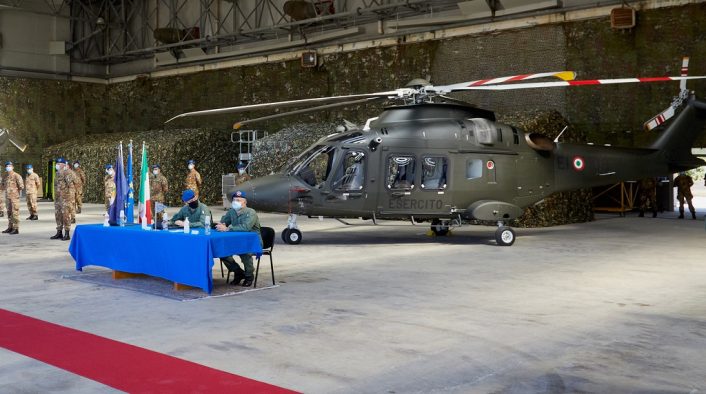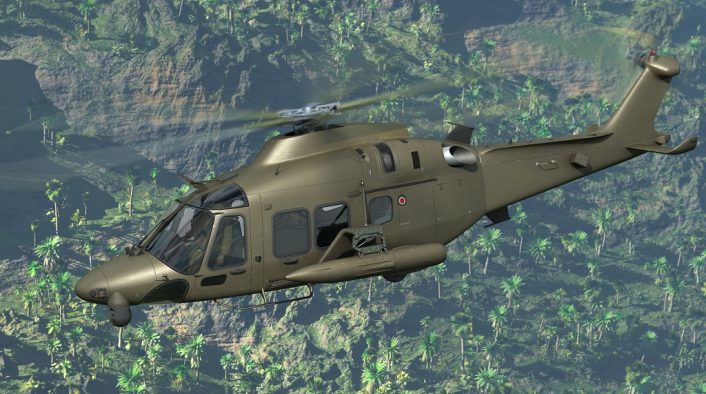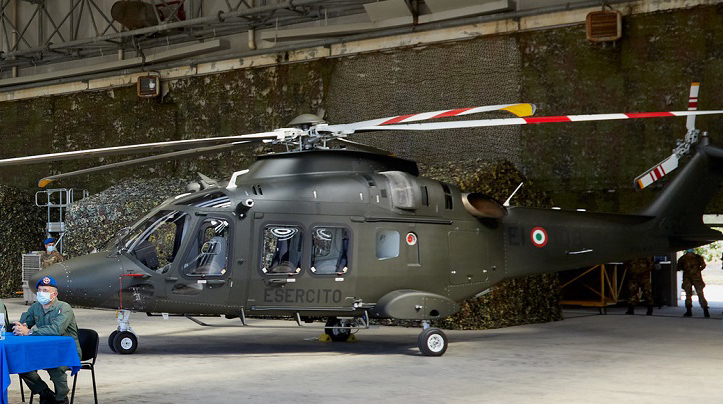The Army Aviation will receive two helicopters in this configuration to start training crews that will fly the final LUH multirole variant.
Leonardo Helicopter Division delivered on July 10, 2020 the first of two AW169 Light Utility Helicopters in training configuration to the Italian Army during a ceremony at the 2nd Rtg. Aviazione dell’Esercito “Sirio” (2nd Rgt. Army Aviation “Sirius”, as the Army Aviation regiments are named after constellations), based in Lamezia Terme, southern Italy.
The new helicopters, designated UH-169B by the Army, are formally configured as “Addestratore Basico Commerciale” (Basic Commercial Trainer) and will be used to start the training of the crews that will fly the final configuration of the helicopter, called “Multiruolo Avanzato” (Advanced Multirole).
The UH-169B is based on the AW169M, the military variant of the AW169 light intermediate twin-engine helicopter, designed to carry out a wide range of tasks, including utility, surveillance, special operations, maritime patrol, land reconnaissance, training, rescue and firefighting.

According to the Italian Ministry of Defence, the Light Utility Helicopter will replace the ageing Combat Support Helicopters (Elicotteri da Supporto al Combattimento, ESC) currently in service, like the A-109, AB-205, AB-206, AB-212 and AB-412, while filling the gaps due to the obsolescence of the current fleet and optimizing logistics with a single-platform fleet, instead of the current one based on five different helicopters that were put in service between the 1970s and the 1990s.
Gian Piero Cutillo, Managing Director of Leonardo Helicopters, said during the delivery ceremony: “It gives us great pleasure to celebrate with the Italian Army the delivery of its first AW169 in basic training configuration as an essential enabler ahead of the implementation of the new, broader LUH programme. The LUH will definitely represent the start of a new era in terms of capabilities, technical support, mission flexibility and interoperability in the light weight segment. The new programme takes advantage of many decades of a successful partnership and continued exchange of information, intended to fully understand the changing operational needs and how to address them through the possibilities offered by new technologies. We’re committed to supporting the Italian Army to maximise the benefits of these new helicopters.”

The requirements set for the program by the MoD requested an helicopter that was already in service in other Italian armed forces and law enforcement agencies, with Command and Control (C2) systems already in service or in the acquisition phase, a service life of 10’000 flight hours or no less than 30 years and the capability to communicate and transmit images and videos to the troops on the ground, both with Italian assets and in a joint/NATO environment, following the Army’s Forza NEC (Network Enabled Capability) program.
The helicopter has also to perform in a “dual use” role for civilian Search And Rescue (SAR), MEDical EVAcuation (MEDEVAC), surveillance, firefighting and support in the event of natural calamities, as was also explained by our Editor David Cenciotti in a previous article:
“Dual use” is a term that refers technologies that can be used for military and civilian purposes.
“Dual use” has also become a sort of mantra of the Italian approach to the defense matters. Investments, developments, exercises: it looks like no military activity can be carried out just because it serves specific defense purposes, it must also support civilian operations. Actually, the Italian Armed Forces have always been “Dual”, regularly conducting peacetime operations in support of the population. Search And Rescue, Humanitarian Relief, Medical Transportation, Medical Evactuation, Firefighting, National Security: these are just a few of the many missions regularly carried out by the Italian military for the community.
However, especially in recent times, the “Dual use” purpose of the military technologies has increasingly emerged in official statements and public discussions, as if being “Dual” made choices pertaining to the defense, which are periodically at the center of political controversy, more acceptable.
The advanced multirole configuration of the AW169 LUH currently in development will feature dedicated flight and mission equipment including NVG-compatible integrated glass cockpit, advanced C4 systems (Command, Control, Communication and Computers), rescue hoist and rappelling/fast roping equipment, Electro-Optical/Infra-Red (EO/IR) system, self-defense systems, searchlight, loudspeakers, cargo hook and both internal and external weapon stations.
The program called for 22 helicopters in both versions when it was presented last year to the Italian Parliament, with the most recent public preliminary report from ARMAEREO (Direzione degli Armamenti Aeronautici e per l’Aeronavigabilità or Aeronautical Armaments and Airworthiness Directorate) mentioning 15 helicopters in the advanced multirole configuration.
As a side note, together with the first contract for the LUH program, the Italian Parliament also approved the acquisition of 17 new HH-139A SAR helicopters for the Italian Air Force, that will join the 13 helicopters already in service.









